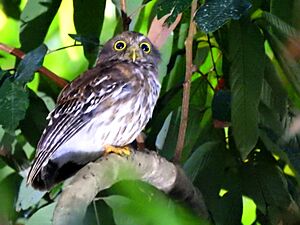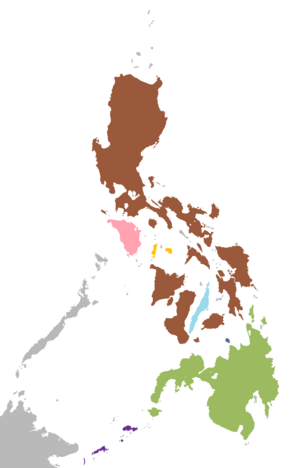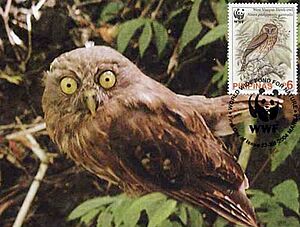Luzon boobook facts for kids
Quick facts for kids Luzon boobook |
|
|---|---|
 |
|
| Ninox philippensis philippinensis seen in Laguna | |
| Conservation status | |
| Scientific classification | |
| Genus: |
Ninox
|
| Species: |
philippensis
|
 |
|
| Brown: Luzon Hawk Owl Ninox philippensis, including N. p. ticaoensis and N. p. centralis | |
The Luzon boobook or Luzon hawk-owl (Ninox philippensis) is a type of owl. It belongs to the Strigidae family, which includes many kinds of owls. This owl lives only in the Philippines. It makes its home in the forests there. It has brown and white patterns on its feathers. Male and female Luzon boobooks look very much alike.
Contents
What Does the Luzon Boobook Look Like?
The Luzon boobook is one of the smallest owls in the Philippine hawk-owl family. It has white marks above its eyes, like eyebrows. It also has a white "moustache" shape near its beak. This makes an X-shape on its head.
This owl does not have feather tufts that look like ears. Its upper body is brown. Its wings have white, oval-shaped spots. The tail is dark brown with thin white stripes.
The sides of its head are brown. Its chin is a whitish color. The rest of its underside is pale white. It has wide brown streaks, especially on its chest. The underside of its tail is white. Its feet are partly covered with feathers and are pale yellow. The beak is olive green.
Different Kinds of Luzon Boobooks
There are three main types, or subspecies, of the Luzon boobook. They are found in different parts of the Philippines:
- Ninox philippensis centralis lives on islands like Bohol, Boracay, Negros, and Panay.
- Ninox philippensis philippensis is found on Luzon, Leyte, Samar, and other nearby islands.
- Ninox philippensis ticaoensis lives only on Ticao.
Where Do Luzon Boobooks Live and What Do They Eat?
The Luzon boobook lives in forest areas. They can be found up to about 1,800 meters (5,900 feet) above sea level. However, they usually live in areas below 1,000 meters (3,300 feet).
Their natural habitats are warm, wet lowland forests. They also live in moist montane forests, which are forests on mountains. These owls hunt for insects and small rodents to eat.
Luzon Boobook Reproduction
The breeding season for these owls starts around February. They make their nests in hollows inside trees.
Is the Luzon Boobook in Danger?
The Luzon boobook is quite common in the areas where it lives. The number of these owls is thought to be stable. They do not face any major threats right now.
Because of this, the IUCN (International Union for Conservation of Nature) has listed them as "least concern". This means they are not currently at risk of disappearing. They can also live in secondary forests (forests that have grown back) and clearings.



